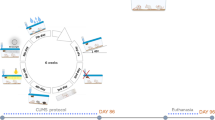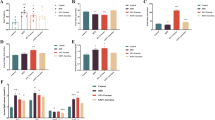Abstract
Rationale
3-(4-Fluorophenylselenyl)-2,5-diphenylselenophene (F-DPS) is a promising organoselenium compound that shows antidepressant-like properties related to interaction with the serotonergic system.
Objectives
In this study, a mouse model of anxiety/depressant-like behavior induced by long-term corticosterone treatment was used to evaluate behavioral, endocrinal, and neurochemical changes in mice and their possible modulation of F-DPS treatment.
Methods
Swiss mice were subjected to 4 weeks of corticosterone administration (20 μg/ml in drinking water) and a new therapeutic approach with F-DPS (0.1 mg/kg/day, intragastric route, during 1 week) was employed to modulate changes induced by corticosterone exposure.
Results
Treatment with corticosterone caused a significant depressant-like behavior in the forced swimming test and tail suspension test, which was accompanied by anxiety-like condition in the light–dark test and novelty suppressed-feeding; similarly to the classical antidepressant drug paroxetine, F-DPS treatment was effective in reversing these behavioral changes. Further, F-DPS normalized serum levels of corticosterone and adrenocorticotropic hormone, which were increased after corticosterone exposure. Corticosterone also significantly inhibited glutamate uptake in the prefrontal cortex of mice, whereas glutamate release was not modified. Besides normalizing glutamate uptake in the corticosterone-exposed mice, F-DPS promoted an inhibition of 5-HT uptake in the prefrontal cortex and hippocampus. In addition, hippocampal monoamine oxidase-A activity was also inhibited by F-DPS treatment.
Conclusions
These findings suggest a modulation of both serotonergic and glutamatergic systems by F-DPS after a long-term corticosterone exposure in mice, which may be involved in the antidepressant- and anxiolytic-like actions of this organoselenium compound.








Similar content being viewed by others
References
Ago Y, Yano K, Araki R, Hiramatsu N, Kita Y, Kawasaki T, Onoe H, Chaki S, Nakazato A, Hashimoto H, Baba A, Takuma K, Matsuda T (2013) Metabotropic glutamate 2/3 receptor antagonists improve behavioral and prefrontal dopaminergic alterations in the chronic corticosterone-induced depression model in mice. Neuropharmacology 65:29–38
Andrisano C, Chiesa A, Serretti A (2013) Newer antidepressants and panic disorder: a meta-analysis. Int Clin Psychopharmacol 28:33–45
Antoni FA (1993) Vasopressinergic control of pituitary adrenocorticotropin secretion comes of age. Front Neuroendocrinol 14:76–122
Autry AE, Adachi M, Nosyreva E, Na ES, Los MF, Cheng PF, Kavalali ET, Monteggia LM (2011) NMDA receptor blockade at rest triggers rapid behavioural antidepressant responses. Nature 475:91–95
Bagley J, Moghaddam B (1997) Temporal dynamics of glutamate efflux in the prefrontal cortex and in the hippocampus following repeated stress: effects of pretreatment with saline or diazepam. Neuroscience 77:65–73
Banasr M, Chowdhury GM, Terwilliger R, Newton SS, Duman RS, Behar KL, Sanacora G (2010) Glial pathology in an animal model of depression: reversal of stress-induced cellular, metabolic and behavioral deficits by the glutamate-modulating drug riluzole. Mol Psychiatry 15:501–511
Bandelow B, Zohar J, Hollander E, Kasper S, Moller HJ, Allgulander C, Ayuso-Gutierrez J, Baldwin DS, Buenvicius R, Cassano G, Fineberg N, Gabriels L, Hindmarch I, Kaiya H, Klein DF, Lader M, Lecrubier Y, Lepine JP, Liebowitz MR, Lopez-Ibor JJ, Marazziti D, Miguel EC, Oh KS, Preter M, Rupprecht R, Sato M, Starcevic V, Stein DJ, van Ameringen M, Vega J (2008) World Federation of Societies of Biological Psychiatry (WFSBP) guidelines for the pharmacological treatment of anxiety, obsessive-compulsive and post-traumatic stress disorders—first revision. World J Biol Psychiatry 9:248–312
Berman RM, Cappiello A, Anand A, Oren DA, Heninger GR, Charney DS, Krystal JH (2000) Antidepressant effects of ketamine in depressed patients. Biol Psychiatry 47:351–354
Bosch OG, Seifritz E, Wetter TC (2012) Stress-related depression: neuroendocrine, genetic, and therapeutical aspects. World J Biol Psychiatry 13:556–568
Bourin M, Hascoet M (2003) The mouse light/dark box test. Eur J Pharmacol 463:55–65
Bradford MM (1976) A rapid and sensitive method for the quantitation of microgram quantities of protein utilizing the principle of protein–dye binding. Anal Biochem 72:248–254
Cirulli F, Francia N, Berry A, Aloe L, Alleva E, Suomi SJ (2009) Early life stress as a risk factor for mental health: role of neurotrophins from rodents to non-human primates. Neurosci Biobehav Rev 33:573–585
Cryan JF, Holmes A (2005) The ascent of mouse: advances in modelling human depression and anxiety. Nat Rev Drug Discov 4:775–790
Danese A, McEwen BS (2012) Adverse childhood experiences, allostasis, allostatic load, and age-related disease. Physiol Behav 106:29–39
David DJ, Samuels BA, Rainer Q, Wang JW, Marsteller D, Mendez I, Drew M, Craig DA, Guiard BP, Guilloux JP, Artymyshyn RP, Gardier AM, Gerald C, Antonijevic IA, Leonardo ED, Hen R (2009) Neurogenesis-dependent and -independent effects of fluoxetine in an animal model of anxiety/depression. Neuron 62:479–493
De Kloet ER, Vreugdenhil E, Oitzl MS, Joels M (1998) Brain corticosteroid receptor balance in health and disease. Endocr Rev 19:269–301
de Kloet ER, Karst H, Joels M (2008) Corticosteroid hormones in the central stress response: quick-and-slow. Front Neuroendocrinol 29:268–272
Gai BM, Stein AL, Roehrs JA, Bilheri FN, Nogueira CW, Zeni G (2012) Synthesis and antidepressant-like activity of selenophenes obtained via iron(III)–PhSeSePh-mediated cyclization of Z-selenoenynes. Org Biomol Chem 10:798–807
Gay BM, Prigol M, Stein AL, Nogueira CW (2010) Antidepressant-like pharmacological profile of 3-(4-fluorophenylselenyl)-2,5-diphenylselenophene: involvement of serotonergic system. Neuropharmacology 59:172–179
Gourley SL, Kiraly DD, Howell JL, Olausson P, Taylor JR (2008a) Acute hippocampal brain-derived neurotrophic factor restores motivational and forced swim performance after corticosterone. Biol Psychiatry 64:884–890
Gourley SL, Wu FJ, Kiraly DD, Ploski JE, Kedves AT, Duman RS, Taylor JR (2008b) Regionally specific regulation of ERK MAP kinase in a model of antidepressant-sensitive chronic depression. Biol Psychiatry 63:353–359
Gourley SL, Wu FJ, Taylor JR (2008c) Corticosterone regulates pERK1/2 map kinase in a chronic depression model. Ann N Y Acad Sci 1148:509–514
Gourley SL, Espitia JW, Sanacora G, Taylor JR (2012a) Antidepressant-like properties of oral riluzole and utility of incentive disengagement models of depression in mice. Psychopharmacology (Berl) 219:805–814
Gourley SL, Swanson AM, Jacobs AM, Howell JL, Mo M, Dileone RJ, Koleske AJ, Taylor JR (2012b) Action control is mediated by prefrontal BDNF and glucocorticoid receptor binding. Proc Natl Acad Sci U S A 109:20714–20719
Gray EG, Whittaker VP (1962) The isolation of nerve endings from brain: an electron-microscopic study of cell fragments derived by homogenization and centrifugation. J Anat 96:79–88
Groeneweg FL, Karst H, de Kloet ER, Joels M (2012) Mineralocorticoid and glucocorticoid receptors at the neuronal membrane, regulators of nongenomic corticosteroid signalling. Mol Cell Endocrinol 350:299–309
Harvey BH (1997) The neurobiology and pharmacology of depression. A comparative overview of serotonin selective antidepressants. S Afr Med J 87(540–50):552
Himmerich H, Zimmermann P, Ising M, Kloiber S, Lucae S, Kunzel HE, Binder EB, Holsboer F, Uhr M (2007) Changes in the hypothalamic–pituitary–adrenal axis and leptin levels during antidepressant treatment. Neuropsychobiology 55:28–35
Karst H, Berger S, Turiault M, Tronche F, Schutz G, Joels M (2005) Mineralocorticoid receptors are indispensable for nongenomic modulation of hippocampal glutamate transmission by corticosterone. Proc Natl Acad Sci U S A 102:19204–19207
Krajl M (1965) A rapid microfluorimetric determination of monoamine oxidase. Biochem Pharmacol 14:1684–1686
Li N, Lee B, Liu RJ, Banasr M, Dwyer JM, Iwata M, Li XY, Aghajanian G, Duman RS (2010) mTOR-dependent synapse formation underlies the rapid antidepressant effects of NMDA antagonists. Science 329:959–964
Lowy MT, Wittenberg L, Yamamoto BK (1995) Effect of acute stress on hippocampal glutamate levels and spectrin proteolysis in young and aged rats. J Neurochem 65:268–274
Matsumoto T, Furuta T, Nimura Y, Suzuki O (1984) 3-(p-hydroxyphenyl)propionic acid as a new fluorogenic reagent for amine oxidase assays. Anal Biochem 138:133–136
Migues PV, Leal RB, Mantovani M, Nicolau M, Gabilan NH (1999) Synaptosomal glutamate release induced by the fraction Bc2 from the venom of the sea anemone Bunodosoma caissarum. Neuroreport 10:67–70
Millan MJ (2006) Multi-target strategies for the improved treatment of depressive states: conceptual foundations and neuronal substrates, drug discovery and therapeutic application. Pharmacol Ther 110:135–370
Murray F, Smith DW, Hutson PH (2008) Chronic low dose corticosterone exposure decreased hippocampal cell proliferation, volume and induced anxiety and depression like behaviours in mice. Eur J Pharmacol 583:115–127
Nogueira CW, Rocha JB (2011) Toxicology and pharmacology of selenium: emphasis on synthetic organoselenium compounds. Arch Toxicol 85:1313–1359
O’Dwyer AM, Lightman SL, Marks MN, Checkley SA (1995) Treatment of major depression with metyrapone and hydrocortisone. J Affect Disord 33:123–128
Olausson P, Kiraly DD, Gourley SL, Taylor JR (2013) Persistent effects of prior chronic exposure to corticosterone on reward-related learning and motivation in rodents. Psychopharmacology (Berl) 225:569–577
Pan Y, Zhang WY, Xia X, Kong LD (2006) Effects of icariin on hypothalamic–pituitary–adrenal axis action and cytokine levels in stressed Sprague–Dawley rats. Biol Pharm Bull 29:2399–2403
Pariante CM, Lightman SL (2008) The HPA axis in major depression: classical theories and new developments. Trends Neurosci 31:464–468
Paul IA, Skolnick P (2003) Glutamate and depression: clinical and preclinical studies. Ann N Y Acad Sci 1003:250–272
Porsolt RD, Bertin A, Blavet N, Deniel M, Jalfre M (1979) Immobility induced by forced swimming in rats: effects of agents which modify central catecholamine and serotonin activity. Eur J Pharmacol 57:201–210
Rainer Q, Xia L, Guilloux JP, Gabriel C, Mocaer E, Hen R, Enhamre E, Gardier AM, David DJ (2011) Beneficial behavioural and neurogenic effects of agomelatine in a model of depression/anxiety. Int J Neuropsychopharmacol 1–15
Reznikov LR, Grillo CA, Piroli GG, Pasumarthi RK, Reagan LP, Fadel J (2007) Acute stress-mediated increases in extracellular glutamate levels in the rat amygdala: differential effects of antidepressant treatment. Eur J Neurosci 25:3109–3114
Rocha FF, Lima-Landman MT, Souccar C, Tanae MM, De Lima TC, Lapa AJ (2007) Antidepressant-like effect of Cecropia glazioui Sneth and its constituents—in vivo and in vitro characterization of the underlying mechanism. Phytomedicine 14:396–402
Santarelli L, Saxe M, Gross C, Surget A, Battaglia F, Dulawa S, Weisstaub N, Lee J, Duman R, Arancio O, Belzung C, Hen R (2003) Requirement of hippocampal neurogenesis for the behavioral effects of antidepressants. Science 301:805–809
Schule C, Baghai TC, Eser D, Zwanzger P, Jordan M, Buechs R, Rupprecht R (2006) Time course of hypothalamic–pituitary–adrenocortical axis activity during treatment with reboxetine and mirtazapine in depressed patients. Psychopharmacology (Berl) 186:601–611
Soto-Otero R, Mendez-Alvarez E, Hermida-Ameijeiras A, Sanchez-Sellero I, Cruz-Landeira A, Lamas ML (2001) Inhibition of brain monoamine oxidase activity by the generation of hydroxyl radicals: potential implications in relation to oxidative stress. Life Sci 69:879–889
Stein DJ, Zungu-Dirwayi N, van Der Linden GJ, Seedat S (2000) Pharmacotherapy for posttraumatic stress disorder. Cochrane Database Syst Rev: CD002795
Stein AL, Alves D, da Rocha JT, Nogueira CW, Zeni G (2008) Copper iodide-catalyzed cyclization of (Z)-chalcogenoenynes. Org Lett 10:4983–4986
Steru L, Chermat R, Thierry B, Simon P (1985) The tail suspension test: a new method for screening antidepressants in mice. Psychopharmacology (Berl) 85:367–370
Tardito D, Milanese M, Bonifacino T, Musazzi L, Grilli M, Mallei A, Mocaer E, Gabriel-Gracia C, Racagni G, Popoli M, Bonanno G (2010) Blockade of stress-induced increase of glutamate release in the rat prefrontal/frontal cortex by agomelatine involves synergy between melatonergic and 5-HT2C receptor-dependent pathways. BMC Neurosci 11:68
Thomazi AP, Godinho GF, Rodrigues JM, Schwalm FD, Frizzo ME, Moriguchi E, Souza DO, Wofchuk ST (2004) Ontogenetic profile of glutamate uptake in brain structures slices from rats: sensitivity to guanosine. Mech Ageing Dev 125:475–481
Wilhelm EA, Gai BM, Souza AC, Bortolatto CF, Roehrs JA, Nogueira CW (2012a) Involvement of GABAergic and glutamatergic systems in the anticonvulsant activity of 3-alkynyl selenophene in 21 day-old rats. Mol Cell Biochem 365:175–180
Wilhelm EA, Souza AC, Gai BM, Chagas PM, Roehrs JA, Nogueira CW (2012b) Hyperthermic seizures enhance responsiveness to pentylenetetrazole and induce cognitive dysfunction: protective effect of 3-alkynyl selenophene. Life Sci 90:666–672
Zarate CA Jr, Singh JB, Carlson PJ, Brutsche NE, Ameli R, Luckenbaugh DA, Charney DS, Manji HK (2006) A randomized trial of an N-methyl-D-aspartate antagonist in treatment-resistant major depression. Arch Gen Psychiatry 63:856–864
Acknowledgments
The financial support by UFSM, CAPES, FAPERGS/CNPq (PRONEX) research grant # 10/0005-1, and FAPERGS #10/0711-6 is gratefully acknowledged. BMG, CFB, and CWN are recipients of CNPq fellowships. The experiments comply with the current Brazilian laws on the Protection of Animals.
Conflict of interest
The authors declare no conflicts of interest in the present study.
Author information
Authors and Affiliations
Corresponding author
Rights and permissions
About this article
Cite this article
Gai, B.M., Bortolatto, C.F., Heck, S.O. et al. An organoselenium compound improves behavioral, endocrinal and neurochemical changes induced by corticosterone in mice. Psychopharmacology 231, 2119–2130 (2014). https://doi.org/10.1007/s00213-013-3361-9
Received:
Accepted:
Published:
Issue Date:
DOI: https://doi.org/10.1007/s00213-013-3361-9




